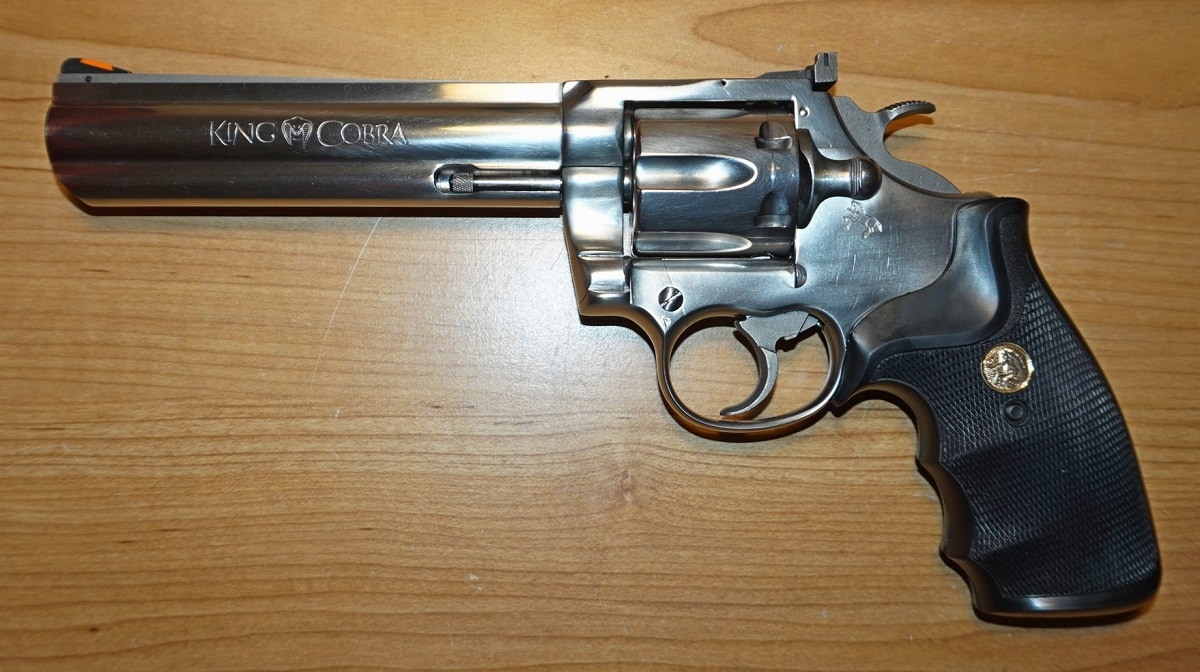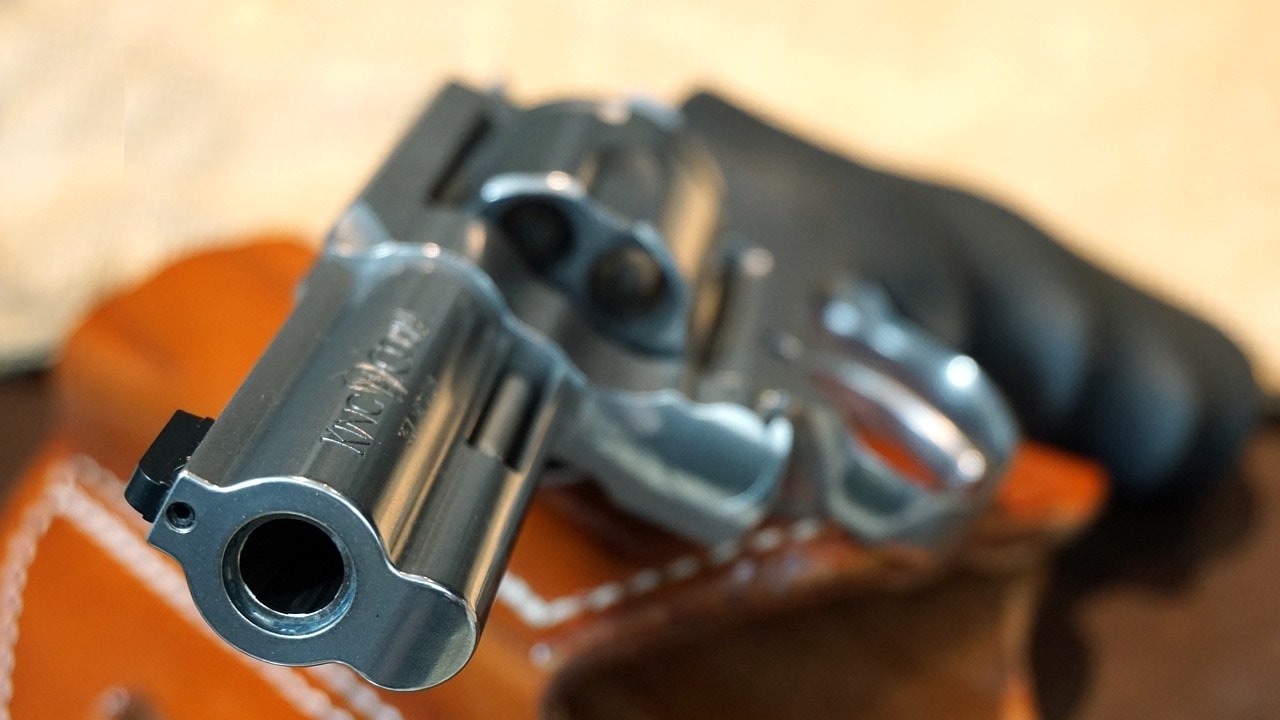It has been said that the Ruger GP-100 can be analogous to the Timex of .357 Magnum revolvers. Then the Colt Python is the Rolex. What’s more, the prestigious Python was the first in Colt’s “Snake Gun” line of double-action revolvers, which also included the Diamondback and Cobra in .38 Special, the King Cobra in .357 Magnum, and the Anaconda in .44 Mag. Sadly, Colt discontinued all of these Snake Guns at one point. Happily, with the exception of the Diamondback, Colt is bringing ‘em back. In the case of the King Cobra, that pleases me greatly, as it’s an old sentimental favorite of mine (as I shall elaborate upon later).
Origins and Specifications
The original Colt King Cobra was introduced in 1986 and produced until 1992 and again from 1994 to 1998. It was a mid-size wheelgun built upon Colt’s so-called “V-frame,” the company’s answer to Smith & Wesson’s “K-frame” medium-sized revolvers. The gun was offered in blued and stainless finish options, with most versions sharing black, finger-grooved, neoprene stocks, and solid barrel ribs; these latter features both help to absorb the recoil of the harder-kicking Magnum loads, and the solid barrel rib in particular shows the influence of the Python.
It was at the 2019 SHOT Show in Las Vegas that Colt announced the resurrection of this particular species of Snake Gun. This time around, according to the manufacturer’s official info page, the gun was “reincarnated for 2019 as the 6-Shot .357 Magnum big brother of the Colt Cobra Double Action revolver,” which in turn had been reintroduced back in 2017. As noted by John Zent, Editor Emeritus of NRA American Rifleman Magazine:
“The new King Cobra bears a close resemblance, with the notable exception of its elongated, rectangular trigger guard big enough for former boxers or shooters wearing gloves. The re-issue’s frame is quite stout—’heavy-duty’ in company parlance—including a 0.60″-wide topstrap beveled to meet the solid barrel rib, plus a full-length underlug with a cutout for the ejector rod. When at rest, less hammer is exposed than in the earlier design. Overall dimensions of the 3″ model are 8″x5″x1.4″, and, at 28 ozs., it is one of the lightest in the .357 Mag., six-shot class. The longer Target variant weighs 36 ozs., while the Carry, coming with a bobbed hammer in double-action-only, is a slim 26 ozs … The entire run is rendered in stainless steel with a brushed finish that falls between the matte and bright stainless options on earlier King Cobras.”
My Experience Firing the King Cobra
The King Cobra is an old sentimental favorite of mine, as it was both the first revolver of any kind and the first Magnum-caliber handgun I ever fired. Such an unforgettable day it was: my first day learning how to shoot, at the tender age of 14, back on October 28, 1989, at the Santa Anita Firing Range (sadly now defunct, it was where that memorable firing range scene from the original Lethal Weapon movie was filmed) in Monrovia, Calif. Starting off with a Colt .380 ACP auto, followed by a Beretta .25 ACP, a Chipmunk single-shot bolt-action rifle in .22LR … and then topping off with that Snake Gun – a 4-incher – with the full-powered Magnum loads and a dozen rounds of leftover ammo that the range attendants were nice enough to gift to me.
Being new to shooting, I did all of my shooting at seven yards. And even though I was a mere 5’2” and a rain-thin 100 lbs. soaking wet and with corresponding hand size, I found the gun’s recoil, muzzle rise, and muzzle blast and flash to be exhilarating rather than punishing or intimidating. Accuracy-wise … well, I did okay for a rookie, I reckon.
Fast-forward to February 1991, and I returned to Santa Anita Firing Range, this time with a year-and-a-half of shooting experience under my belt and my shooting techniques – grip, stance, etc. – considerably refined thanks to the positive influence of Massad F. Ayoob’s books. This time I went with 50 rounds of ammo (jacketed semiwadcutter range reloads), with head shots at seven yards and torso shots at the 15- and 25-yard lines. Accuracy was a breeze, thanks to the smooth trigger in double-action and single-action trigger modes alike – not as smooth as the Python, mind you, but still plenty smooth – an easily acquirable sight picture, and those recoil-taming rubber grips.
Bottom Line: Yea or Nay?
While on the one hand, I’ve read some good reviews of the newer King Cobra – such as Mr. Zent’s previously cited article – some of the clerks at my local gun shops in the DC/MD/NoVA have told me some less-than-stellar things about these newer models. Partially for these reasons, but mainly for reasons of nostalgia, I’d be more inclined to purchase a surplus revolver from the original production run on the used gun market, either a four-inch or a six-incher (though Lord knows the three-inch would be more practical for CCW purposes). The problem is, they’re hard to find at a reasonable price. In fact, back in mid-2020, I did attempt to bid for a beautiful six-inch King Cobra on GunBroker.Com, but alas, my bidding attempt fell short at $800.00, so some other lucky well-heeled schmoe got the gun instead. Drat!

Image: Creative Commons.

Image: Creative Commons.

Revolver Colt King Cobra .357 Magnum
Oh well, maybe next time …
MORE: The F-35 Now Comes in Beast Mode
MORE: Why the U.S. Navy Tried to Sink Their Own Aircraft Carrier
Christian D. Orr has 33 years of shooting experience, starting at the tender age of 14. His marksmanship accomplishments include: the Air Force Small Arms Ribbon w/one device (for M16A2 rifle and M9 pistol); Pistol Expert Ratings from U.S. Customs & Border Protection (CBP), Immigration & Customs Enforcement (ICE), and the Federal Law Enforcement Training Center (FLETC) Criminal Investigator Training Program (CITP); multiple medals and trophies via the Glock Sport Shooting Foundation (GSSF) and the Nevada Police & Fires Games (NPAF). Chris has been an NRA Certified Basic Pistol Instructor since 2011. In his spare time, he enjoys (besides shooting, obviously) dining out, cigars, Irish and British pubs, travel, USC Trojans college football, and Washington DC professional sports.

